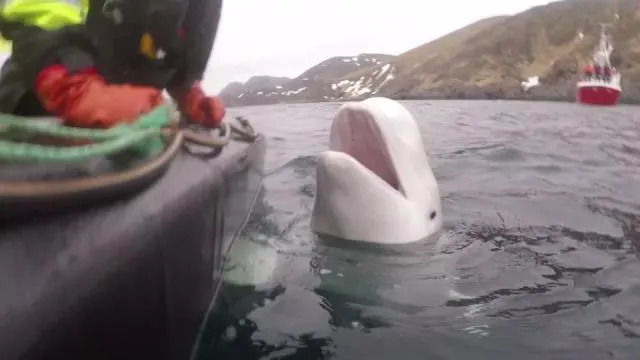People should “avoid contact” with a famous beluga whale to avoid accidentally injuring or killing it, Norway’s Directorate of Fisheries has said.
The whale, nicknamed Hvaldimir, rose to international fame in 2019 after it was spotted wearing a special harness with brackets for a camera, leading experts to believe it may have been trained by the Russian military.
Hvaldimir has been cruising the Norwegian coast (Credit: Jorgen Ree Wiig/Norwegian Directorate of Fisheries).
Since 2019, it “has been traveling along the Norwegian coast” with a few stops along the way, according to the directorate, which added that Hvaldimir “tends to stay in hatcheries where it has been able to catch fish, feeding excessively on food.”
Hvaldimir is known to follow boats and play with those on board.
The whale, a protected species in Norway, now lives inside the Oslo Fjord, according to the Directorate of Fisheries.
This “means that it has reached a very densely populated area, and the risk that the whale could be injured due to human contact is significantly higher,” it added.
In a statement Wednesday, Fisheries Director Frank Bakke-Jensen said that “so far there have only been minor incidents where the whale has suffered minor injuries, mainly from contact with boats.”
But he urged people to keep their distance, “even though the whale is tame and used to being close to people.”
“We especially encourage people on boats to keep a good distance to avoid the whale being injured or, in the worst case, killed by boat traffic,” Bakke-Jensen said.
Given the dangers, Bakke-Jensen was asked whether the whale should be placed in captivity.
“We have always communicated that the whale in question is a free-living animal and we see no reason to capture it and put it behind barriers,” she said.
However, now that the whale is “in a more vulnerable area and access to food may be limited, we will consider different measures,” Bakke-Jensen added. “But it’s still too early to say anything concrete about it.”
The Fisheries Directorate will monitor the whale’s movements in the hope that it will turn around when it reaches the end of the Oslofjord.
In 2019, experts told CNN that Hvaldimir was a tame animal, and evidence suggested it came from Russia.
Jorgen Ree Wiig, a marine biologist with the Norwegian Directorate of Fisheries, told CNN that the harness looked “specially made” and had “GoPro camera mounts on either side of it.”
And the clips on the harness read “Equipment St. Petersburg,” contributing to the theory that the whale came from Murmansk, Russia, and had been trained by the Russian navy.
The navy “has been known to train beluga whales to conduct military operations before,” Wiig said, “such as guarding naval bases, assisting divers, finding lost equipment.”

